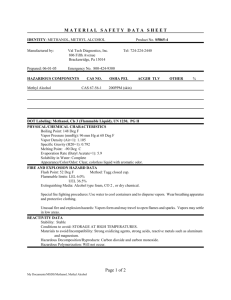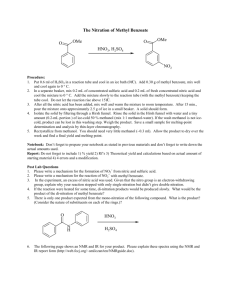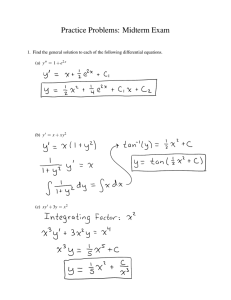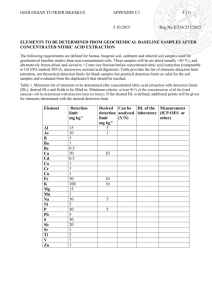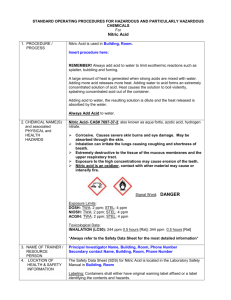SDS – SAFETY DATA SHEET
advertisement
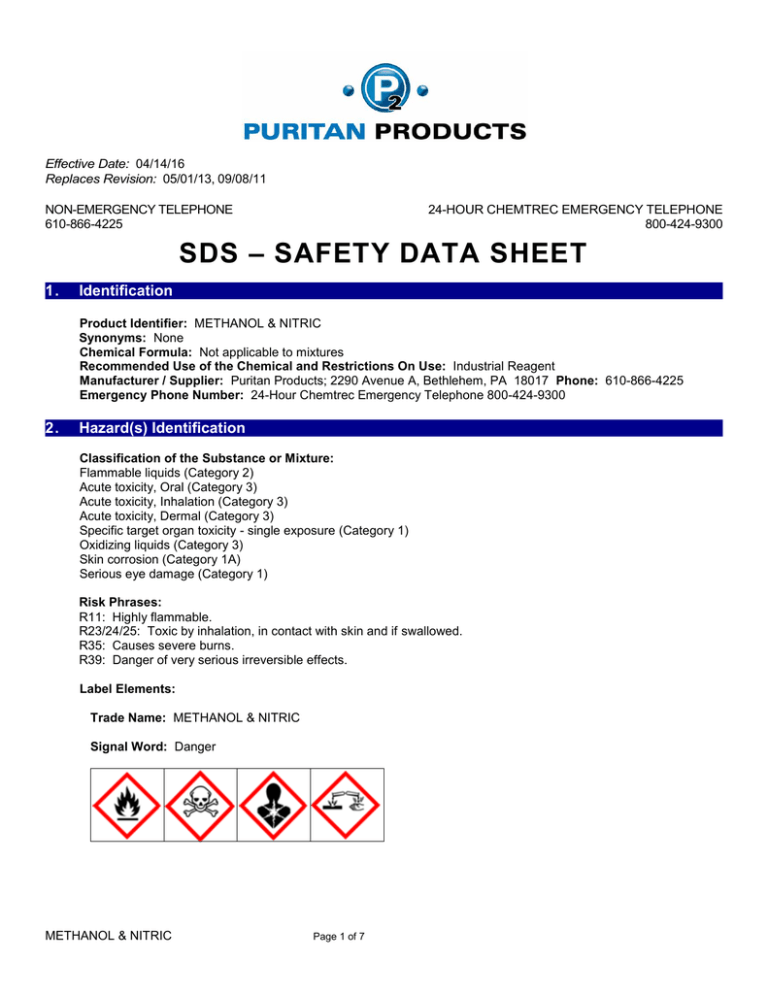
Effective Date: 04/14/16 Replaces Revision: 05/01/13, 09/08/11 NON-EMERGENCY TELEPHONE 610-866-4225 24-HOUR CHEMTREC EMERGENCY TELEPHONE 800-424-9300 SDS – SAFETY DATA SHEET 1. Identification Product Identifier: METHANOL & NITRIC Synonyms: None Chemical Formula: Not applicable to mixtures Recommended Use of the Chemical and Restrictions On Use: Industrial Reagent Manufacturer / Supplier: Puritan Products; 2290 Avenue A, Bethlehem, PA 18017 Phone: 610-866-4225 Emergency Phone Number: 24-Hour Chemtrec Emergency Telephone 800-424-9300 2. Hazard(s) Identification Classification of the Substance or Mixture: Flammable liquids (Category 2) Acute toxicity, Oral (Category 3) Acute toxicity, Inhalation (Category 3) Acute toxicity, Dermal (Category 3) Specific target organ toxicity - single exposure (Category 1) Oxidizing liquids (Category 3) Skin corrosion (Category 1A) Serious eye damage (Category 1) Risk Phrases: R11: Highly flammable. R23/24/25: Toxic by inhalation, in contact with skin and if swallowed. R35: Causes severe burns. R39: Danger of very serious irreversible effects. Label Elements: Trade Name: METHANOL & NITRIC Signal Word: Danger METHANOL & NITRIC Page 1 of 7 Hazard Statements: H225: Highly flammable liquid and vapor. H301 + H311: Toxic if swallowed or in contact with skin. H331: Toxic if inhaled. H370: Causes damage to organs. Precautionary Statements: P210: Keep away from heat / sparks / open flames / hot surfaces. No smoking. P220: Keep / Store away from clothing / combustible materials. P260: Do not breathe dust / fume / gas / mist / vapors / spray. P280: Wear protective gloves / protective clothing. P310: Immediately call a POISON CENTER or doctor / physician. P305 + P351 + P338: IF IN EYES: Rinse cautiously with water for several minutes. Remove contact lenses, if present and easy to do. Continue rinsing. 3. Composition / Information on Ingredients CAS Number: Not applicable to mixtures EC Number: Not applicable to mixtures Index Number: Not applicable to mixtures Molecular Weight: Not applicable to mixtures Ingredient Methyl Alcohol Nitric Acid Water 4. CAS Number 67-56-1 7697-37-2 7732-18-5 EC Number 200-659-6 231-714-2 231-791-2 Percent 50 - 90% 1 - 35% 1 - 25% Hazardous Yes Yes No Chemical Characterization Substance Substance Mixture First-aid Measures Inhalation: Remove to fresh air. If not breathing, give artificial respiration. If breathing is difficult, give Oxygen. Get medical attention immediately. Ingestion: DO NOT INDUCE VOMITING! Give large amounts of water or milk if available. Never give anything by mouth to an unconscious person. Get medical attention immediately. Skin Contact: In case of contact, immediately flush skin with plenty of water for at least 15 minutes while removing contaminated clothing and shoes. Get medical attention immediately. Wash clothing before reuse. Thoroughly clean shoes before reuse. Eye Contact: Immediately flush eyes with plenty of water for at least 15 minutes, lifting lower and upper eyelids occasionally. Get medical attention immediately. 5. Fire-fighting Measures Fire: Flammable Liquid and Vapor! Flash point: 12C (54F) CC / Autoignition temperature: 464C (867F) Flammable limits in air % by volume: uel: 36, lel: 6.0 Explosion: Above flash point, vapor-air mixtures are explosive within flammable limits noted above. Moderate explosion hazard and dangerous fire hazard when exposed to heat, sparks or flames. Sensitive to static discharge. Fire Extinguishing Media: Use alcohol foam, dry chemical or Carbon Dioxide. Water may be ineffective. Special Information: In the event of a fire, wear full protective clothing and NIOSH-approved self-contained breathing apparatus with full face piece operated in the pressure demand or other positive pressure mode. Use water spray to blanket fire, cool fire exposed containers, and to flush non-ignited spills or vapors away from fire. Vapors can flow along surfaces to distant ignition source and flash back. METHANOL & NITRIC Page 2 of 7 6. Accidental Release Measures Personal Precautions, Protective Equipment and Emergency Procedures: Ventilate area of leak or spill. Remove all sources of ignition. Wear appropriate personal protective equipment as specified in Section 8. Isolate hazard area. Keep unnecessary and unprotected personnel from entering. Environmental Precautions and Methods and Materials for Containment and Cleaning Up: Contain and recover liquid when possible. Use non-sparking tools and equipment. Neutralize with alkaline material (soda ash, lime), then absorb with an inert material (e. g., vermiculite, dry sand, earth), and place in a chemical waste container. Do not flush to sewer! If a leak or spill has not ignited, use water spray to disperse the vapors, to protect personnel attempting to stop leak, and to flush spills away from exposures. US Regulations (CERCLA) require reporting spills and releases to soil, water and air in excess of reportable quantities. The toll free number for the US Coast Guard National Response Center is (800) 424-8802. 7. Handling and Storage Precautions for Safe Handling and Conditions for Safe Storage, Including Any Incompatibilities: Protect against physical damage. Store in a cool, dry well-ventilated location, away from any area where the fire hazard may be acute. Outside or detached storage is preferred. Separate from incompatibles. Containers should be bonded and grounded for transfers to avoid static sparks. Storage and use areas should be No Smoking areas. Use non-sparking type tools and equipment, including explosion proof ventilation. Containers of this material may be hazardous when empty since they retain product residues (vapors, liquid.) Observe all warnings and precautions listed for the product. DO NOT attempt to clean empty containers since residue is difficult to remove. Do not pressurize, cut, weld, braze, solder, drill, grind or expose such containers to heat, sparks, flame, static electricity or other sources of ignition: they may explode and cause injury or death. 8. Exposure Controls / Personal Protection Airborne Exposure Limits: For Methyl Alcohol: OSHA Permissible Exposure Limit (PEL): 200 ppm (TWA) ACGIH Threshold Limit Value (TLV): 200 ppm (TWA), 250 ppm (STEL) skin For Nitric Acid: OSHA Permissible Exposure Limit (PEL): 2 ppm (TWA), 4 ppm (STEL) ACGIH Threshold Limit Value (TLV): 2 ppm (TWA); 4 ppm (STEL) Ventilation System: A system of local and / or general exhaust is recommended to keep employee exposures below the Airborne Exposure Limits. Local exhaust ventilation is generally preferred because it can control the emissions of the contaminant at its source, preventing dispersion of it into the general work area. Please refer to the ACGIH document, Industrial Ventilation, A Manual of Recommended Practices, most recent edition, for details. Use explosion-proof equipment. Personal Respirators (NIOSH Approved): If the exposure limit is exceeded and engineering controls are not feasible, wear a supplied air, full face piece respirator, air-lined hood, or full face piece self-contained breathing apparatus. Breathing air quality must meet the requirements of the OSHA respiratory protection standard (29CFR1910.134). Canister-type respirators using sorbents are ineffective. Skin Protection: Wear impervious protective clothing, including boots, gloves, lab coat, apron or coveralls, as appropriate, to prevent skin contact. Eye Protection: Use chemical safety goggles and / or a full face shield where splashing is possible. Maintain eye wash fountain and quick-drench facilities in work area. 9. Physical and Chemical Properties Appearance: Clear, colorless liquid Odor: Characteristic odor Odor Threshold: Not determined pH: No information found % Volatiles by volume @ 21C (70F): 100 Melting Point: -98C (-144F) METHANOL & NITRIC Page 3 of 7 Boiling Point / Boiling Range: 64.5C (147F) Flash Point: 12C (54F) CC Evaporation Rate (BuAC=1): 5.9 Flammability: Flammable Liquid and Vapor! Upper / Lower Flammability or Explosive Limits: Upper – 36 / Lower – 6.0 Vapor Pressure (mm Hg): No information found Vapor Density (Air=1): ~ 1.1 Relative Density: No information found Solubility: Miscible in water Partition Coefficient: n-octanol / water: No information found Auto-ignition Temperature: 464C (867F) Decomposition Temperature: No information found Viscosity: No information found 10. Stability and Reactivity Reactivity and / or Chemical Stability: Stable under ordinary conditions of use and storage. Possibility of Hazardous Reactions and Conditions to Avoid: Heat, flames, ignition sources and incompatibles. Incompatible Materials: Strong oxidizing agents such as nitrates, perchlorates, or Sulfuric Acid. Strong bases, metallic powders, carbides, Hydrogen Sulfide. Will attack some forms of plastics, rubber, and coatings. May react with metallic Aluminum and generate Hydrogen gas. Hazardous Decomposition Products: May form Carbon Dioxide, Carbon Monoxide, Formaldehyde, toxic Nitrogen oxides fumes and Hydrogen Nitrate when heated to decomposition. 11. Toxicological Information Emergency Overview: POISON! DANGER, CORROSIVE LIQUID! VAPOR HARMFUL. MAY BE FATAL OR CAUSE BLINDNESS IF SWALLOWED. HARMFUL IF INHALED OR ABSORBED THROUGH SKIN. CANNOT BE MADE NON-POISONOUS. FLAMMABLE LIQUID AND VAPOR. CAUSES IRRITATION TO SKIN, EYES AND RESPIRATORY TRACT. AFFECTS CENTRAL NERVOUS SYSTEM AND LIVER! ACID MISTS CAUSE SEVERE BURNS TO ALL BODY TISSUE. OXIDIZER. CONTACT WITH OTHER MATERIAL MAY CAUSE FIRE. MAY BE FATAL IF SWALLOWED. HARMFUL IF INHALED. INHALATION MAY CAUSE LUNG AND TOOTH DAMAGE. Potential Health Effects: Inhalation: A slight irritant to the mucous membranes. Toxic effects exerted upon nervous system, particularly the optic nerve. Once absorbed into the body, it is very slowly eliminated. Symptoms of overexposure may include headache, drowsiness, nausea, vomiting, blurred vision, blindness, coma, and death. A person may get better but then worse again up to 30 hours later. Corrosive! May cause irritation of the nose, throat, and respiratory tract including coughing and choking. Higher concentrations or prolonged exposure to vapors of Nitric Acid may lead to pneumonia or pulmonary edema. Ingestion: Toxic. Symptoms parallel inhalation. Can intoxicate and cause blindness. Usual fatal dose: 100-125 milliliters. Corrosive! May cause redness, pain, and severe skin burns. Skin Contact: Methyl Alcohol is a defatting agent and may cause skin to become dry and cracked. Skin absorption can occur; symptoms may parallel inhalation exposure. Eye Contact: Corrosive! Vapors are irritating and may cause severe damage to the eyes. Splashes may cause severe burns and permanent eye damage. Continued exposure may cause eye lesions. Chronic Exposure: Marked impairment of vision has been reported. Repeated or prolonged exposure may cause skin irritation. Long-term exposure to concentrated vapors may cause erosion of teeth. Long term exposures seldom occur due to the corrosive properties of the acid. Aggravation of Pre-existing Conditions: Persons with pre-existing skin disorders or eye problems or impaired liver or kidney function or cardiopulmonary diseases may be more susceptible to the effects of the substance. METHANOL & NITRIC Page 4 of 7 Specific Target Organ Toxicity - Single Exposure (Globally Harmonized System:) Causes damage to organs. Specific Target Organ Toxicity - Repeated Exposure (Globally Harmonized System:) No data available. Numerical Measures of Toxicity: Cancer Lists: NTP Carcinogen Ingredient Known Methyl Alcohol (67-56-1) No Nitric Acid (7697-37-2) No Water (7732-18-5) No Anticipated No No No IARC Category None None None Acute Toxicity: For Methyl Alcohol: Oral rat LD50: 5628 mg/kg; inhalation rat LC50: 64000 ppm/ 4h; skin rabbit LD50: 15800 mg/kg; Irritation data-standard Draize test: skin, rabbit: 20mg/24 hr. Moderate; eye, rabbit: 100 mg / 24 h. Moderate. Investigated as a mutagen, reproductive effecter. For Nitric Acid: Oral (human) LDLo: 430 mg/kg Inhalation,rat, LC50: 67 ppm (NO2)/ 4h Investigated as a mutagen, reproductive effecter. 12. Ecological Information Ecotoxicity: The product may affect the acidity (pH-factor) in water with risk of harmful effects to aquatic organisms. For Methyl Alcohol: Toxicity to fish LC50 - Oncorhynchus mykiss (rainbow trout) - 19,000.00 mg/l - 96 h / mortality LC50 - Lepomis macrochirus (Bluegill) - 15,400 mg/l - 96 h Toxicity to daphnia and other aquatic invertebrates - EC50 - Daphnia magna (Water flea) - 24,500.00 mg/l - 48 h / EC100 - Daphnia magna (Water flea) - 10,000.00 mg/l - 24 h Toxicity to algae Growth inhibition EC50 - Scenedesmus capricornutum (fresh water algae) - 22,000 mg/l - 96 h For Nitric Acid: LC50 - Asterias rubens - 100 - 330 mg/l - 48 h Persistence and Degradability: When released into the soil, this material is expected to readily biodegrade. When released into water, this material is expected to readily biodegrade. When released into the air, his material is expected to be readily degraded by reaction with photochemically produced hydroxyl radicals. Bioaccumulative Potential: Data for Methyl Alcohol: Bioaccumulation Cyprinus carpio (Carp) - 72 d at 20C Bioconcentration factor (BCF): 1.0 No bioaccumulation expected for Nitric Acid Mobility in Soil: When released into the soil, this material is expected to quickly evaporate. When released into the soil, this material is expected to leach into groundwater. Other adverse effects: When released into the water, this material is expected to have a half-life between 1 and 10 days. When released into the air, this material is expected to exist in the aerosol phase with a short half-life. When released into air, this material is expected to have a half-life between 10 and 30 days. When released into the air, this material is expected to be readily removed from the atmosphere by wet deposition. 13. Disposal Considerations Whatever cannot be saved for recovery or recycling should be handled as hazardous waste and sent to a RCRA approved incinerator or disposed in a RCRA approved waste facility. Processing, use or contamination of this product may change the waste management options. State and local disposal regulations may differ from federal disposal regulations. Dispose of container and unused contents in accordance with federal, state and local requirements. METHANOL & NITRIC Page 5 of 7 14. Transport Information UN Number: UN2924 UN Proper Shipping Name: FLAMMABLE LIQUID, CORROSIVE, N.O.S. (CONTAINS METHANOL AND NITRIC ACID) Packing Group: II DOT IMDG IATA Land Transport ADR/RID and GGVS/GGVE (Cross Border / Domestic) Transport Hazard Class(es): 3, 8 Maritime Transport IMDG/GGVSea Transport Hazard Class(es): 3, 8 Marine Pollutant: No Air Transport ICAO-TI and IATA-DGR Transport Hazard Class(es): 3, 8 Transport in Bulk according to Annex II of MARPOL 73/78 and the IBC Code Special Precautions for User: No additional information 15. Regulatory Information Chemical Inventory Status – Part 1 Ingredient Methyl Alcohol (67-56-1) Nitric Acid (7697-37-2) Water (7732-18-5) TSCA Yes Yes Yes Chemical Inventory Status – Part 2 Ingredient Korea Methyl Alcohol (67-56-1) Nitric Acid (7697-37-2) Water (7732-18-5) EC Yes Yes Yes Japan Yes Yes Yes Canada DSL Yes Yes Yes Yes Yes Yes Australia Yes Yes Yes Phil. NDSL No No No Yes Yes Yes Federal, State & International Regulations - Part 1 SARA 302 Ingredient Methyl Alcohol (67-56-1) Nitric Acid (7697-37-2) Water (7732-18-5) METHANOL & NITRIC RQ No 1000 No Page 6 of 7 TPQ No 1000 No SARA 313 List Chemical Catg. Yes No Yes No No No Federal, State & International Regulations - Part 2 Ingredient Methyl Alcohol (67-56-1) Nitric Acid (7697-37-2) Water (7732-18-5) Chemical Weapons Convention: No SARA 311/312: Acute: Yes Reactivity: Yes RCRA CERCLA 5000 1000 No TSCA 261.33 U154 No No TSCA 12(b): No Chronic: Yes Fire: Yes Mixture / Liquid 8(d) No No No CDTA: No Pressure: No Australian Hazchem Code: 2PE Poison Schedule: S6 16. Other Information Revision 04/14/16 – modified Effective Date THE INFORMATION CONTAINED IN THIS DATA SHEET IS BASED ON THE DATA AVAILABLE TO PURITAN PRODUCTS AT THIS TIME. WHILE BELIEVED TO BE ACCURATE, PURITAN PRODUCTS DOES NOT CLAIM IT TO BE ALL INCLUSIVE. IT IS PROVIDED INDEPENDENT OF ANY SALE OF THE PRODUCT, FOR THE PURPOSE OF HAZARD COMMUNICATION, AND AS A GUIDE FOR THE APPROPRIATE PRECAUTIONARY HANDLING OF THE PRODUCT BY PROPERLY TRAINED INDIVIDUALS. IT IS NOT INTENDED TO PROVIDE PRODUCT PERFORMANCE OR APPLICABILITY INFORMATION, AND NO EXPRESS OR IMPLIED WARRANTY OF ANY KIND IS MADE WITH RESPECT TO THE PRODUCT, THE UNDERLYING PRODUCT DATA, OR THE INFORMATION CONTAINED HEREIN. YOU ARE URGED TO OBTAIN MATERIAL SAFETY DATA SHEETS FOR ALL PRODUCTS YOU BUY, PROCESS, USE OR DISTRIBUTE, AND ARE ENCOURAGED TO ADVISE THOSE WHO MAY COME IN CONTACT WITH SUCH PRODUCTS OF THE INFORMATION CONTAINED THEREIN. TO DETERMINE THE APPLICABILITY OR EFFECT OF ANY LAW OR REGULATION WITH RESPECT TO THE PRODUCT, YOU SHOULD CONSULT WITH YOUR LEGAL ADVISOR OR THE APPROPRIATE GOVERNMENT AGENCY. WE WILL NOT PROVIDE ADVICE ON SUCH MATTERS, OR BE RESPONSIBLE FOR ANY INJURY OR DAMAGE RESULTING FROM THE USE OF THE PRODUCT DESCRIBED HEREIN. METHANOL & NITRIC Page 7 of 7
